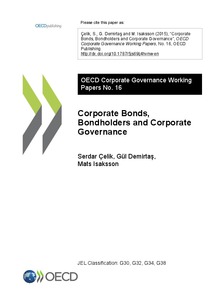Corporate bonds, bondholders and corporate governance
"Worldwide, primary corporate bond markets have become an increasingly important source of financing for non-financial companies. This trend is coupled with a relative decrease in traditional bank lending to non-financial companies and low levels of bond interest rates. Just as shareholders, bo...
| Main Authors: | , , |
|---|---|
| Institution: | ETUI-European Trade Union Institute |
| Format: | TEXT |
| Language: | English |
| Published: |
Paris
2015
OECD |
| Subjects: | |
| Online Access: | https://www.labourline.org/KENTIKA-19113607124919318899-Corporate-bonds,-bondholders-a.htm |
| Summary: | "Worldwide, primary corporate bond markets have become an increasingly important source of financing for non-financial companies. This trend is coupled with a relative decrease in traditional bank lending to non-financial companies and low levels of bond interest rates. Just as shareholders, bondholders can play an important role in corporate governance. They can use both exit and voice. This report provides a comprehensive global overview of all corporate bond issues since 2000 and experiences of governance engagement by bondholders. The report builds on issue level data for more than 100,000 individual bond issues in 108 jurisdictions between 2000 and 2013. Data is provided with respect to the type of issues and numerous bond characteristics, such as country of origin, investment grade, maturity, covenants and conditions for redemption. The report also analyses trends in secondary bond markets, including market liquidity, the role of market makers and the relatively slow introduction of electronic trading systems. In order to analyse trends over time with respect to governance, we provide detailed time series data on the use and relative importance of 15 different categories of covenants. By constructing an overall "covenant protection index" we suggest that bond investors in their search for yield have overall traded governance rights for higher expected returns. This shift also seems to be associated with higher risk-taking. We also conclude that the degree of governance engagement primarily is linked to the business model of the bond investor. We end the report with a discussion about the scope for institutional changes that may build a larger community of truly informed and motivated bond investors." |
|---|---|
| Physical Description: | 65 p. Digital |

